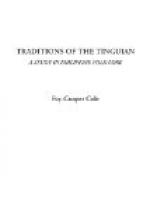[340] Peculiarly shaped stones in which Apdel, the guardian spirit of the village is supposed to reside.
[341] A Tinguian town several miles south of Patok.
[342] Told by the people of Lumaba, to account for a peculiar knifelike cut in one of the guardian stones outside the village.
[343] Large knife.
[344] Account of the securing of the guardian stones at Lagayan, Abra.
[345] Compare with account of La Gironiere, Twenty Years in the Philippines, pp. 120 ff; also with Cole, Philippine Journal of Science, Vol. III, No. 4, 1908, pp. 210-11.
[346] A ceremony held while the body is still in the house.
[347] A grass which is eaten.
[348] Taboo. A fire is kept burning at the grave and at the foot of the house ladder for ten nights following the burial. During this time the members of the family and near relatives must remain close to home.
[349] A barrio of Patok.
[350] A rope lasso.
[351] An evil spirit.
[352] People in the house with the dead and the relatives must observe the kanyau (taboo) for ten days or they will meet the spirit of the dead person and it will harm them.
[353] Smilax vicaria Kunth.
[354] The name by which the Tinguian designate themselves.
[355] Blumea balsamifera D.C.
[356] A blanket with red or yellow stripes which resemble the markings on a young wild pig.
[357] See p. 54, note 2.
[358] A mountain town in eastern Abra.
[359] A ceremony held about a year after a funeral.
[360] See p. 10, note 1.
[361] Spirit name for Tinguian.
[362] The three persons mentioned were still living when this story was recorded.
[363] The name of the spirit of a dead man which still remains near its old haunts.
[364] See p. 28, note 2.
[365] See p. 14.
[366] Head man.
[367] Near Namarabar in Ilocos Sur.
[368] The Ilocano consider the komau a fabulous, invisible bird which steals people and their possessions. See Reyes, El Folklore Filipino, p. 40. Manila, 1899.
[369] A powerful spirit.
[370] See p. 14.
[371] In the Bagobo version of this tale, a ladle becomes the monkey’s tail. See Benedict, Journal American Folklore, Vol. XXVI, 1913, p. 21.
[372] A story accounting for the origin of the kalau, a bird.
[373] See page 10, note 1.
[374] The cave is situated in the mountains, midway between Patok and Santa Rosa.
[375] The old custom was that when a party returned from a head hunt the women went to the gate and held ladders in a [Lambda] so the men did not pass through the gate; or they laid them on the ground and the men jumped over them.
[376] The river emerges from Abra through a narrow pass in the mountains.




